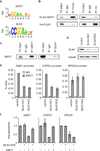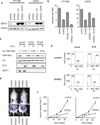SIRT7 links H3K18 deacetylation to maintenance of oncogenic transformation
- PMID: 22722849
- PMCID: PMC3412143
- DOI: 10.1038/nature11043
SIRT7 links H3K18 deacetylation to maintenance of oncogenic transformation
Abstract
Sirtuin proteins regulate diverse cellular pathways that influence genomic stability, metabolism and ageing. SIRT7 is a mammalian sirtuin whose biochemical activity, molecular targets and physiological functions have been unclear. Here we show that SIRT7 is an NAD(+)-dependent H3K18Ac (acetylated lysine 18 of histone H3) deacetylase that stabilizes the transformed state of cancer cells. Genome-wide binding studies reveal that SIRT7 binds to promoters of a specific set of gene targets, where it deacetylates H3K18Ac and promotes transcriptional repression. The spectrum of SIRT7 target genes is defined in part by its interaction with the cancer-associated E26 transformed specific (ETS) transcription factor ELK4, and comprises numerous genes with links to tumour suppression. Notably, selective hypoacetylation of H3K18Ac has been linked to oncogenic transformation, and in patients is associated with aggressive tumour phenotypes and poor prognosis. We find that deacetylation of H3K18Ac by SIRT7 is necessary for maintaining essential features of human cancer cells, including anchorage-independent growth and escape from contact inhibition. Moreover, SIRT7 is necessary for a global hypoacetylation of H3K18Ac associated with cellular transformation by the viral oncoprotein E1A. Finally, SIRT7 depletion markedly reduces the tumorigenicity of human cancer cell xenografts in mice. Together, our work establishes SIRT7 as a highly selective H3K18Ac deacetylase and demonstrates a pivotal role for SIRT7 in chromatin regulation, cellular transformation programs and tumour formation in vivo.
Figures




Comment in
-
A big step for SIRT7, one giant leap for Sirtuins… in cancer.Cancer Cell. 2012 Jun 12;21(6):719-21. doi: 10.1016/j.ccr.2012.05.028. Cancer Cell. 2012. PMID: 22698398
References
-
- Longo VD, Kennedy BK. Sirtuins in aging and age-related disease. Cell. 2006;126:257–268. - PubMed
Publication types
MeSH terms
Substances
Associated data
- Actions
Grants and funding
LinkOut - more resources
Full Text Sources
Other Literature Sources
Molecular Biology Databases
Research Materials

